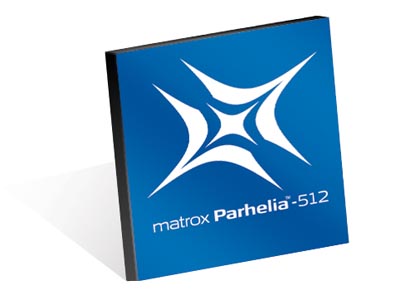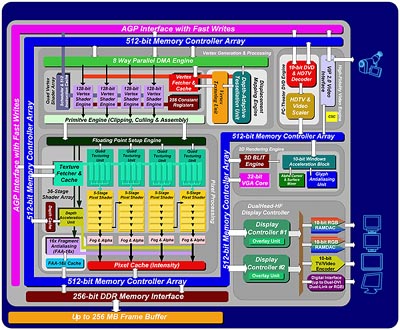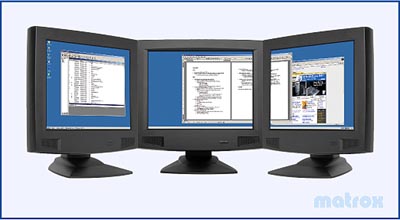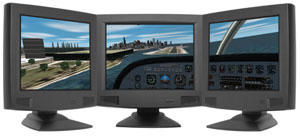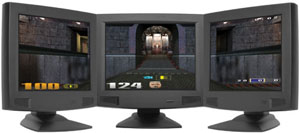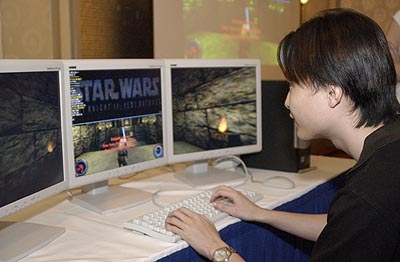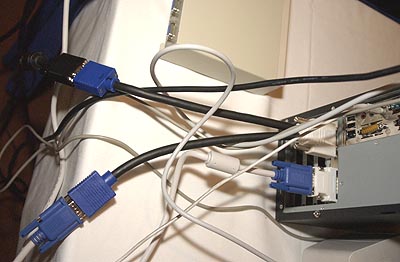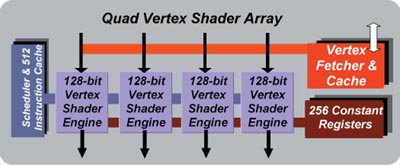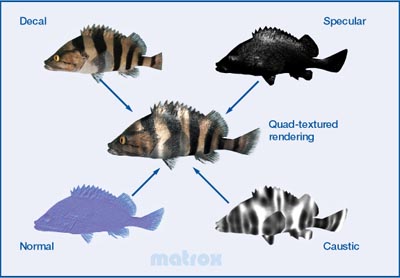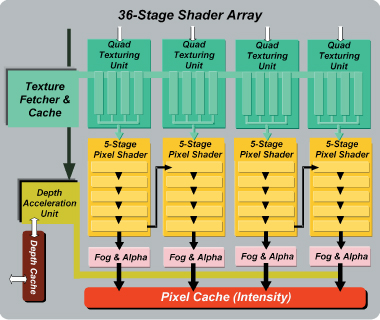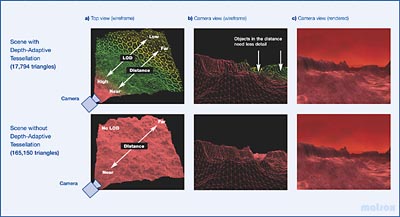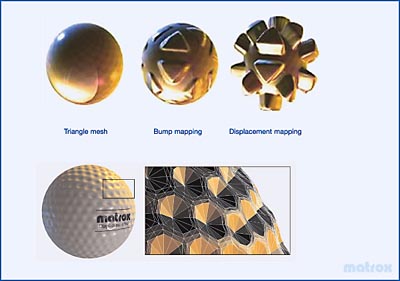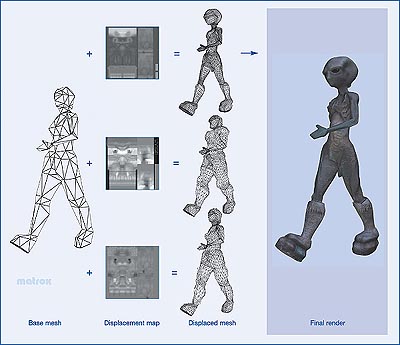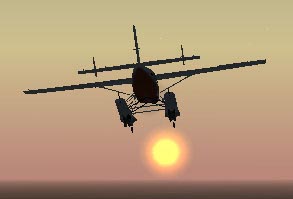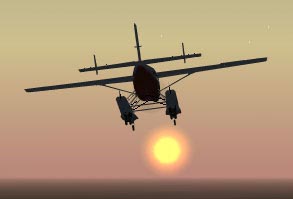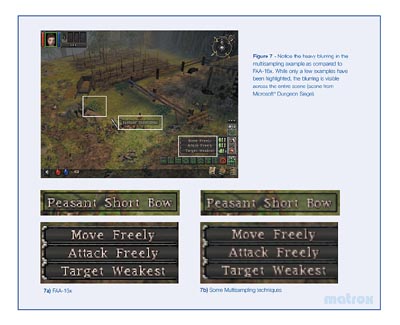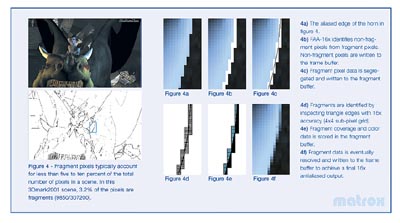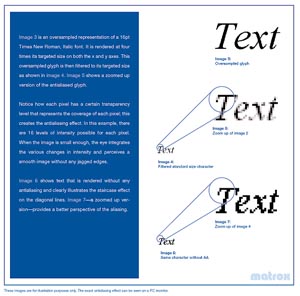Matrox Parhelia-512 : The Technology |
|
 |
By CPU-zilla. |
| Category : Graphics | |
| Approved by Jimmy Tang on Tuesday, 14th of May,2002 |
|
|
So, are you ready to find out more about the next biggest thing that will hit the gaming market? If you are, go on to the next page and be amazed at the list of features. |
|
Matrox Parhelia-512 Technical
Specifications
|
|
In Surround Gaming, 3D scenes will be rendered on two additional monitors, one on each side of the user. Giving users an ultra-wide field of view will greatly enhance and enrich game play with its peripheral viewing capabilities. Imagine playing a first-person shooter game (like Quake 3) while having the advantage of spotting the enemies hiding in the far corner of your eye. All this is possible with this technology. We see this as a terrific support for future 3D games as it not only brings a new level of realism to gaming, but it is here to set a standard in future gaming as well. Chip Hinnenberg of LucasArts' Entertainment Company LLC said, "The Matrox Parhelia-512's Surround Gaming feature gives games new life with its immersive peripheral view capabilities. This is the wave of the future and the way games should be played."
Many other gaming developers agreed too and developers have pledged support for this cool new feature. "The Parhelia-512's Surround Gaming feature could significantly enhance the Massive Multiplayer experience by allowing the user to move many space-intensive HUD items off the primary rendering screen and onto one of the two alternate screens. Having a whole screen dedicated to chat, another dedicated to the 3D world view, and a third for maps, inventory and stats would be wonderful," Jeff Grills, technology director, Sony Online Entertainment, currently working on Star Wars : Galaxies.
Surround Gaming currently supports quite a number of games and its out-of-box support for a wide variety of popular games will make this feature widely acceptable. Developers need not be bounded by developing games specific for this feature. According to Matrox, it works on most games and true enough, they demonstrated TripleHead on popular games like Quake 3 Arena, and the recent Jedi Knight 2 : Jedi Outcast.
With the TripleHead desktop mode, business users or professional graphics designers will once again enjoy an expanded view of their desktop. Let's just say the trend will no longer be a single display for multiple windows, but rather, multiple windows on multiple display screens. The TripleHead feature will produce clear and crisp video output at up to an analog resolution of 3840x1024 at 32-bit color. Of course, DualHead will still be supported and you can still get up to 2048x1536 of display resolution on each analog RGB monitor. If you intend to use digital flat panels, the Parhelia-512 will give you up to 1920x1200 of resolution on each digital display - that's more than enough to fit the next generation of ultra-wide LCD TFT screens.
|
|
Vertex Shader
Comparison with other GPUs
QuadTexturingThe Parhelia-512 is the first GPU to integrate quad pixel quad texturing feature (4x4 texturing). This simply means that there are now four pixel pipes (similar to both GeForce4 and Radeon 8500) and in each pipe, there are four texture stages per pipe. Other GPUs like the GeForce4 and Radeon 8500 only featured two texture stages in each pipe. Thus, the Parhelia-512 can render four textures on four pixels simultaneously in a single pass. Unlike other GPUs, when there are more than 2 textures to be rendered, another pass needs to be performed to complete the texture rendering. On the Parhelia, the rendering completes in one clock cycle - shortening the time by half. This greatly enhances performance throughput especially when the game requires the GPU to perform complex quad texturing.
36-StageShader ArrayIn each of the four pixel pipelines, the Parhelia-512 features four programmable texture stages and five pixel shader stages. This adds up to a total of 36 shader stages. According to Matrox, this gives the Parhelia the power to render some of the most demanding 3D images with unprecedented performance. Other GPUs could only offer up to 16 shader ops, less than half of what the Parhelia offers. However, the question is whether 3D games today would actually take advantage of this massive shader array. Maybe not today and you would certainly not see the difference in performance. Perhaps in the future when games get more realistic, the answer is a big YES. But before that happens, you can be pretty sure that the Parhelia-512 is armed with enough processing power to render next generation games.
|
|
In the first stage, a base mesh with low triangle count is sent to the GPU. The GPU then tessellates the base mesh to increase its triangle count. Increasing the triangle count will help smoothen the displaced surface and adds more detail to the shape. Matrox has also implemented an approach to tessellation and it's called Depth-Adaptive Tessellation. This is a patent-pending technique that allows varying levels of detail (LODs) tessellated across a mesh. By varying the LODs, much of the processing in the GPU can be relieved as there will be less triangles to process.
In the second stage, the position of each vertex of the tessellated mesh is displaced with the displacement map. The pixel values determined by the map will be translated to height information and the shape of the object can be easily defined with this displacement map. This displacement map can be applied to both static base meshes and dynamic, skinned base meshes. This gives the feature a lot more flexibility. In the third and final stage, the displaced mesh will be treated and rendered like any other vertex stream. This means that vertex shaders, textures and pixel shaders can be simply applied to the mesh to create the final rendered image. Alright, now that you know how hardware displacement mapping works, what's the advantages? The advantage lies in its versatility. Firstly, it is hardware accelerated. This simply means that complex geometries can be created without additional load to the CPU. In addtion, the technology helps to create surfaces that's much more realistic than bump-mapping. This will undoubtedly create 3D games with more breathtaking graphics than ever before. Already Matrox has confirmed that this feature has been adapted in one future game title. Amazing, even before Parhelia-512 is released.
Secondly, Hardware Displacement Mapping works with static and skinned meshes. In other words, if used in skinned characters, very detailed 3D characters can be created. The beauty lies in its flexibility to use the same base mesh to render different objects based on different displacement maps. This makes HDM extremely easy to be implemented.
As quoted from Randy Pitchford, president, Gearbox Software, "After seeing Matrox's Hardware Displacement Mapping technology in action, I got kind of giddy. The artists at Gearbox will go nuts for this technology!". Currently, Gearbox is working on Counter-Strike: Condition Zero. |
|
So, if you're uncomfortable with FAA-16x, you can still enable 4x FSAA (Full Scene Antialiasing). But judging from initial screenshots provided by Matrox, FAA-16x does seem to be pretty promising for now. According to Matrox, FAA-16x performance with anisotropic filtering far exceeds Quincunx, SmoothVision or Accuview.
Glyph AntialiasingGlyph antialiasing is introduced not so much for the gamers but for those who wants to read text clearly. It is Matrox's answer to accelerating font rendering through the hardware. This is to take as much of processing away from the CPU as possible. Supported by modern operating systems from Microsoft such as Windows 2000 and Windows XP, Glyph antialiasing also supports independently programmable gamma correction for text.
We think Glyph antialiasing will benefit TFT LCD monitors more as fonts will no longer look hard and cold on the LCD monitors. Antialiasing will soften the look of fonts and this will definitely make reading text on the monitor more enjoyable. Fortunately, only Matrox has actively addressed issues of text clarity and this will definitely make the Parhelia-512 more appealing for business use than any other cards. |
|
All in all, Matrox has once again surprised the graphics industry with a lot of fancy and powerful features. If they can pull through with enough yield to meet the demand, Matrox will definitely capture a large share of the gaming market next quarter provided that the card performs as well as the specifications promised. Today, Matrox is not only out to take the gaming market away from giants like ATI and NVIDIA, but Matrox is actively redefining the future of gaming. With Surround Gaming introduced in the Parhelia-512, there's no doubt that Surround Gaming will be the next big thing in gaming. Matrox deserves a good pat on the back for adding another level of depth and realism to our everyday computing life with TripleHead and Surround Gaming. Of course, the folks from the monitor industry should give Matrox an even bigger pat on the hind since each PC will be potentially accompanied by three monitors. |
